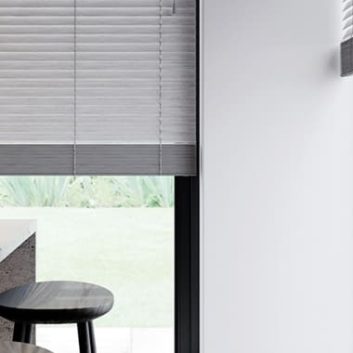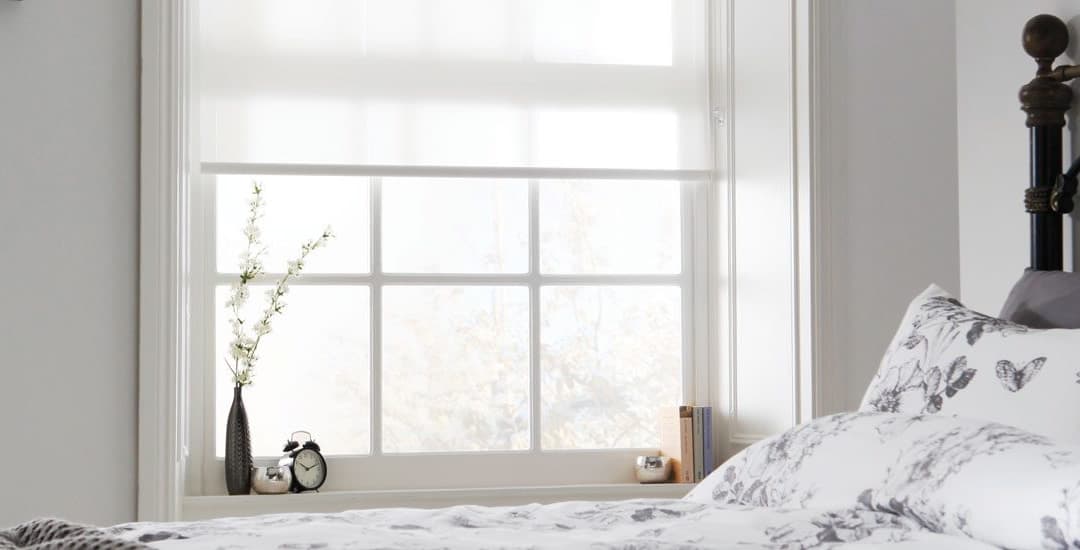
Whether or not you fit your new blinds inside or outside of the window recess usually comes down to personal choice (unless your window itself causes specific limitations) but if you’re buying window blinds, it’s one of the first choices you’re going to have to make!
This is because a blind fitted inside a window recess will be a little smaller than one fitted outside, and so this is a decision you need to make at the point that you measure up and order; you can’t try out both options when your blind arrives to see which looks better.
So, should blinds be fitted inside or outside the recess? In a few cases, the size, depth, or other peculiarities or limitations specific to your window might determine this for you, which is sort of an advantage as you don’t then have to decide for yourself! In most cases though, the look you want to achieve and potentially, how serious you are about blocking out the sun will dictate whether you hang blinds inside or outside the recess.
If you’re trying to choose the best approach and want to make sure you’re not missing anything important before you order, this comprehensive guide will answer the question of “are blinds better inside or outside recesses” based on all of the different things you might need to factor in.
Read on for advice on the factors to consider when asking “should blinds be fitted inside or outside the recess?”
Contents:
- 1. What is a window recess?
- 2. Will blinds actually fit inside of my window recess?
- 3. Why should blinds be fitted inside or outside the recess in different scenarios?
- 3.1. Should blinds be fitted inside or outside the recess if I want the most effective blackout option available?
- 3.2. Should blinds be fitted inside or outside the recess if the window opens inwards rather than outwards?
- 3.3. Should blinds be fitted inside or outside the recess if I have a window seat or a lot of windowsill ornaments?
- 3.4. Should blinds be fitted inside or outside the recess if I have a radiator underneath the window?
- 3.5. What general factors determine if my blinds should be fitted inside or outside of the recess?
- 4. Pros, cons, and considerations when fitting blinds inside the recess
- 5. Pros, cons, and considerations when fitting blinds outside the recess
- 6. Overall, are blinds better inside or outside recesses?
1. What is a window recess?
In case you’ve already fallen at the first hurdle here, I’m going to start off with a quick primer on what a window recess actually is.
A window recess, also known as a “window reveal” (although usually only in interiors circles and/or the USA), is the recessed space around the sides of your window between window and inside wall.
It’s the bit the interior windowsill sits on. The gap between the inside wall of your house and the outside-facing window.
Hopefully this picture should immediately make you go “oh, that!” If not, well you might have windows that don’t have a recess at all, which kind of makes the rest of this article somewhat moot for you, other than that you’ve now Learned a Thing.
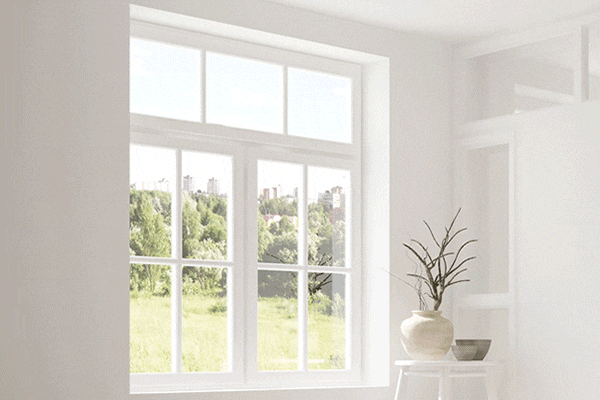
- The depth of a window recess (if you have one at all) can be variable; it may be deep enough to put cushions on the windowsill to sit on, or so narrow that neither a really small ornament nor a fleet-footed cat can balance on the lower surface of it.
- Working out how deep your window recess is in the first instance will help you to determine what options you have in terms of fitting blinds inside or outside the recess, and as a rule, the deeper the recess, the more oyster-y your world of options is.
- If you have a very narrow recess, some types of blinds won’t fit within it at all and will stick out into the room, looking weird (and not in the good way).
- Even if you have a super-cooperatively-wide window recess, this doesn’t mean you have to use it if you don’t want to; you can fit blinds outside of the recess too, it’s up to you.
2. Will blinds actually fit inside of my window recess?
Going back to the point I alluded to above, if your window recess is a particularly narrow one, this might take some choices off the table (or off the windowsill, rather) when it comes to fitting your blinds fully within the recess.
Different types of blinds have different depth requirements before they risk getting the window version of muffin top, which is the sort of information you need to know before, not after, you shell out for a set.
With this in mind, I have sketched out a list of different types of blinds below, along with information on the depth of window recess required to fit each of them successfully without making them look like a dog’s breakfast.
Roller blinds:
- Face-fixed (into the window frame itself) roller blinds need a 70mm or deeper window recess.
- Top-fixed (into the lintel of the window) roller blinds need a 50mm or deeper window recess.
Wood and faux-wood blinds:
- 25mm real or faux wood blinds need a 55mm or deeper window recess.
- 35mm real or faux wood blinds need a 55mm or deeper window recess.
- 50mm real or faux wood blinds need a 65mm or deeper window recess.
Venetian blinds (aluminium blinds):
- 25mm aluminium Venetian blinds need a 30mm or deeper window recess.
Roman blinds:
- Roman blinds need a 50mm or deeper window recess.
Vertical blinds:
- Vertical blinds (with 89mm louvres) need a 75mm or deeper window recess.
Day and night blinds or zebra blinds:
- Face-fixed (into the window frame itself) day and night blinds need a 74mm or deeper window recess.
- Top-fixed (into the lintel of the window) day and night blinds need a 55mm or deeper window recess.
3. Should blinds be fitted inside or outside the recess in different scenarios?
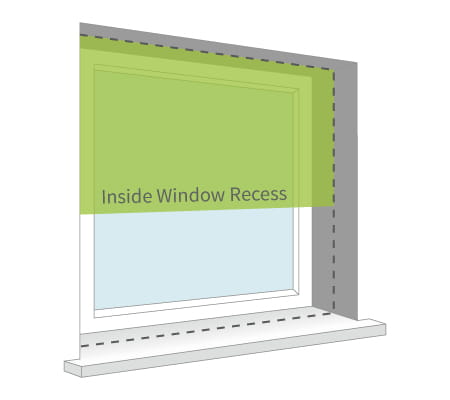
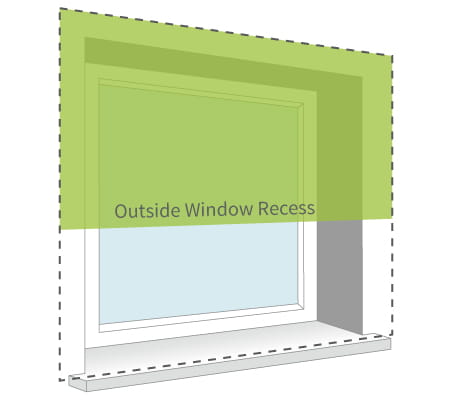
Assuming that you’ve measured up and still have both the inside and outside of the recess options on the table for the type of blinds you’re looking to buy, how do you make a decision on fitting blinds inside or outside of the recess?
It’s worth me first covering a few specific questions that if relevant to you, might largely dictate your choice, before then rounding up the more general points you’ll need to consider/deem relevant or not before going on to cover the pros and cons of hanging blinds inside or outside of the recess respectively.
Should blinds be fitted inside or outside the recess if I want the most effective blackout option available?
If you want to block out as much of the external light that makes it past the blind as you can; first of all, choose blackout blinds. Secondly, consider hanging them outside of the window recess to negate the issue of a small amount of light leakage that can occur around the sides of the blind with blinds inside of the recess.
That said, fitting blackout blinds inside of the recess instead also gives you the option to hang blackout curtains or even to use a second blackout blind outside of the recess to achieve virtually 100% protection from the sun.
Should blinds be fitted inside or outside the recess if the window opens inwards rather than outwards?
If you have windows that open inwards, you might find that blinds fitted inside of the recess soon become a mortal pain in the proverbial, as they get in the way of you opening the window or even prevent you from being able to do so at all!
Should blinds be fitted inside or outside the recess if I have a window seat or a lot of windowsill ornaments?
If you like to keep ornaments on the windowsill and/or have cushions in the window on deeper recesses that you use as a seat, getting to them can be awkward when the blind is closed.
However, this does make the window seat behind a closed blind kind of an awesome place to hide from the kids whilst being able to hear exactly what they’re doing if you are willing to climb in underneath the blind and be quiet…
Should blinds be fitted inside or outside the recess if I have a radiator underneath the window?
One point to note if your window has a radiator directly underneath it; this might remove your option to hang a faux-wood blind outside of the recess.
This is because faux-wood blinds can soften and warp due to prolonged exposure to high heat; while the same blind hung even just a little further from said radiator by means of putting it inside of the recess would be safe, thanks to the increased distance from the heat and closer proximity to the coolness of the window.
What general factors determine if my blinds should be fitted inside or outside the recess?
For most people, it’s just a preference for the appearance of blinds inside or outside of the recess respectively that dictates their choice.
- Most people tend to prefer the appearance of blinds inside of the window recess, as they fit snugly and look neater and tidier; they blend more seamlessly and don’t take up as large a footprint as blinds that lie flat on a wall.
- On the flipside, other folk just prefer the way blinds outside of the recess look and this is fine too; neither option is the “socks with sandals” stylistic choice of the blinds-hanging world.
- If your window recess is very narrow (as per the table above) you might find that some styles of blinds won’t fit snugly inside of the recess and will instead stick out into the room to a degree, in which case you’ll almost certainly think they look better hung outside of the recess instead.
- If your window is small or narrow, consider if the closed blind might take up too much space when hung inside of the recess and in the open position, potentially occluding the light and also looking a bit weird or unbalanced.
4. Pros, cons, and considerations when fitting blinds inside the recess
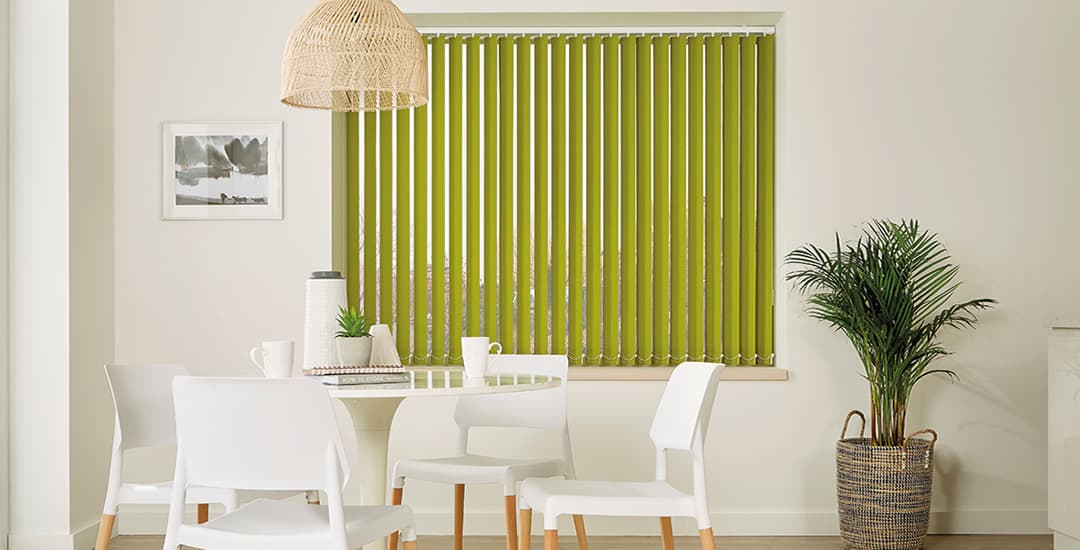
If you’re erring on the side of fitting window blinds inside of the window recess and you’re confident that the recess is large enough to allow for this, here are the pros and cons you should assess before making a final decision.
The pros of fitting blinds inside the window recess:
- If you use blinds that can be tilted to filter light and leave them in the tilted position a lot, inside of the window recess is a good choice as it keeps them neat and out of the way without taking up any external space.
- Blinds fitted inside of the window recess have a smaller footprint, and basically just look neat and tidy.
- The cords and control mechanisms of your blind are nestled within the window recess too, again helping to make them look smart and unobtrusive.
- Blinds hung inside of the recess can be fitted very closely to the window itself, to reduce gaps around the edges that may let in light.
- You can potentially avoid the need to drill through brick or masonry (which requires a little more oomph in terms of both your own elbow grease and potentially, the meatiness of your drill and drill bits) by fitting the blind directly to the window frame itself.
- Blinds fitted inside of the window recess are a shade smaller than those fitted outside, the latter of which need a margin either side to avoid light leakage; and this means that the inside-the-recess option will be slightly cheaper to buy too!
- You can avoid the need to fit a batten before hanging heavier blinds, which is usually strongly recommended for certain blinds hung outside of the recess to ensure it doesn’t fall down!
The cons of fitting blinds inside the window recess:
- When the blind is raised or opened, it will partially cover some of the glass; at the top for most types of blinds like Romans and Venetian blinds, and to one side or the other (or both) for vertical blinds. This can impinge upon both your view, and how much natural light can get in.
- How much the glass is occluded will vary; roller blinds have a relatively small footprint at the top when open, while for Romans this will be rather larger. For verticals, this will depend on the width of the window, and so, width of the concertina of slats.
- The size of the window and its respective height to width ratio will influence how much of a factor this is; for a small window you might not want to lose any space, but for large windows, it may not be an issue. For a tall but narrow window, a swathe of blind material at the top might not cause an issue, but it might if the stack is at the side of the glass, as it would be for a vertical blind.
- The opposite is true for a wide but not tall window; vertical blinds might not take up too much visual real estate, but a horizontally hung blind taking up space at the top might look like a shutter descending!
5. Pros, cons, and considerations when fitting blinds outside the recess
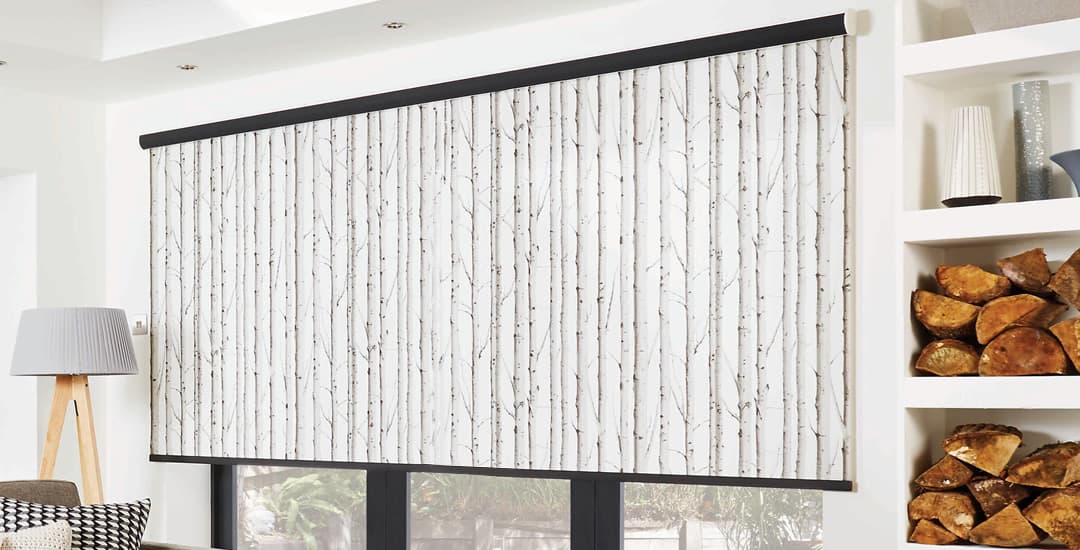
So, what do you need to consider if you’re thinking that outside of the recess is the way forwards?
- The first thing to note is that you’ll want to measure up with an added margin at the top and bottom and on either side of the window recess to ensure you order a blind that covers the window entirely without chinks of light escaping around the edges.
- How large of a margin depends on how much of the wall you’re willing to cover, and how serious you are about blocking the light.
- In terms of the margin at the top of the blind itself, you need to think about whether you want the whole stack of the blind (for horizontal blinds) to close up on the wall and leave the entirety of the glass un-occluded, or if you prefer the more seamless look of having the blind descend a small way down over the recess to avoid a visible gap of wall between blind and window when the blind is open.
The pros of fitting blinds outside the window recess:
- Blinds fitted outside of the window recess are actually less likely/slower to fade or become discoloured as they’re just that shade further away from the sun. This isn’t likely to become a huge or fast issue even in blinds hung inside of the recess, however, as modern blinds are made with a special UV protective agent to prevent (or rather, dramatically slow) this happening.
- You can choose the size of the blind you’d like (space on the wall dependent) rather than being limited to the size of the window recess itself.
- If you leave a sufficient margin in the blind’s width (over 10cm ideally) over all four sides of the wall you hang it on, you’ll reduce light leakage getting past the closed blind considerably; if you’re buying blackout blinds and want them to be as effective as possible, this might be the most critical factor that influences your decision.
- For Roman blinds in particular, most people prefer the appearance they create when fitted outside of the recess. The first reason for this is that Roman blinds are prestigious, luxurious blinds that can form a focal point of their own, and which is displayed most prominently when you can see the entirety of the blind outside of the window recess.
- The second factor is that a Roman blinds concertinas into folds when left in the open position, which if inside of the window recess, will block a chunk of both the view and some of the light. Roman blinds also have a narrow side profile, and so don’t stick out into the room when hung outside of the recess.
- You have more elbow room and room to work when hanging a blind outside of the window recess than you do trying to work and angle tools into a recessed space.
The cons of fitting blinds outside the window recess:
- There’s potentially a little more work involved and one more thing to arrange or get when hanging blinds outside the recess; a batten. For many if not most types of blinds, particularly at the larger end of the size spectrum, a batten is more or less essential to support the weight of the blind and prevent it from eventually being pulled off the wall when some unfortunate soul is trying to open or close it.
- For Roman blinds in particular (and more or less regardless of size) you’re advised to fit a batten if hanging the blind outside of the recess; and for Roman blinds specifically, the additional gap that the batten causes between blind and wall means that from certain (admittedly narrow) angles of view from within the room, you might catch a glimpse of the lift cords and workings on the back of the blind.
- Certain types of blinds – such as vertical blinds, whose louvres do stick out at least 12cm when concertinaed closed or tilted to the 90-degree mark – may protrude into the room more than you’d like in terms of either the visual effect or the space they take up.
6. Overall, are blinds better inside or outside recesses?
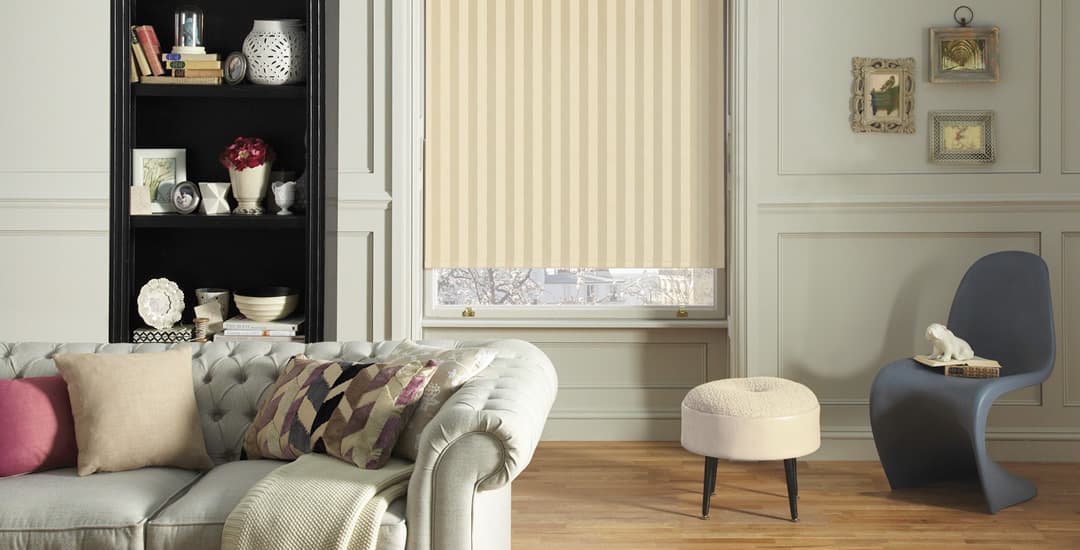
If you skipped straight to the final pages of my novel on whether or not blinds are better inside or outside recesses hoping for a simple resolution to the cliff-hanger in my opening chapter… Sorry, there is not one definitive answer that is right for every blind, window, or person!
I suggest that the key takeaways to note here are to firstly pay some heed to section 2, which will help you to determine if both styles of hanging blinds are on the table for your specific window in the first place.
Then, to check out section 3, where you can get a broad idea of the sort of scenarios that may help you to narrow down your choice, plus get a straight answer to some questions that might directly dictate it, like “should blinds be fitted inside or outside the recess if I want the most effective blackout option available?”
If you’re no further along by this point and both the inside and the outside the recess options are still firmly on the table, start picking through the pros and cons in sections 4 and 5 respectively.
If after that if you’re still on the fence? Firstly, boy I bet you’re really annoying when asked what you’d like for dinner, and secondly, you’re now into “flip a coin” territory, so choose your adventure.
If there is anything I haven’t covered or that doesn’t make sense for you and you’d like to ask me for some direct input as it pertains to your specific issue, feel free to leave me a comment or send me an email and I will see what I can do.

